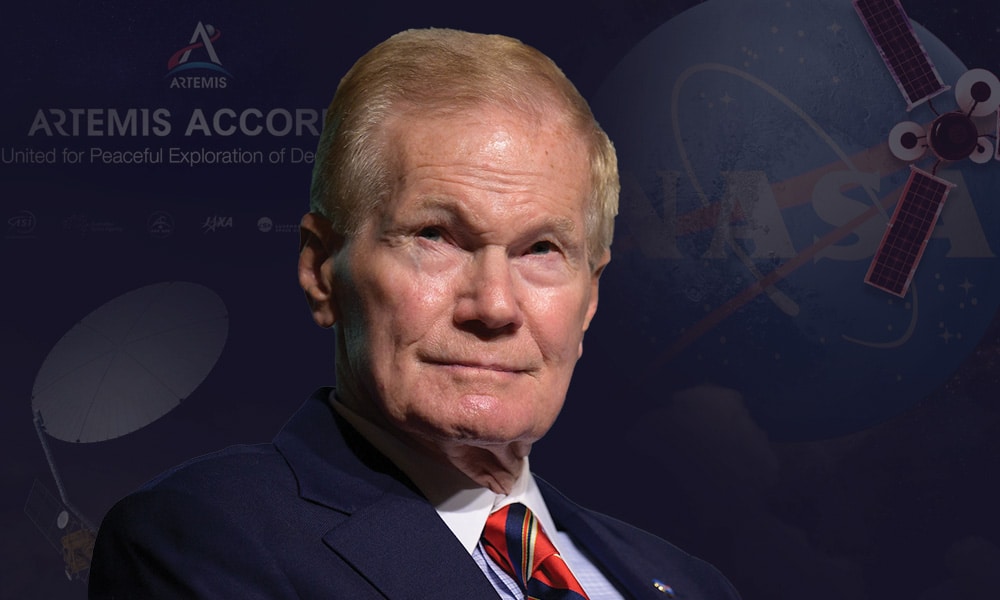
Space shows us time and again that diplomacy is good for discovery, and discovery is good for diplomacy.
Our flagship mission with India, NISAR, will bring revolutionary data about the evolution and state of Earth’s crust, help scientists better understand our planet’s processes and changing climate, and aid future resource and hazard management.
Our international partners – including India – are making remarkable discoveries on the Moon. It was just last year that India’s Chandrayaan-3 landed on the lunar surface, becoming the first nation to land at the South Pole of the Moon.
This mission inspired countless people in India and worldwide, providing key scientific data on the lunar South Pole, which is where the future NASA Artemis missions will land.
We are looking forward to continuing to work with India from Earth to the Moon and, eventually, on Mars, and we are excited about welcoming an Indian astronaut to the International Space Station (ISS).
The Artemis Accords define how we can remain true to, and implement our obligations under the Outer Space Treaty. They reflect a shared commitment to safe, responsible, and transparent behavior in space, to preserve and protect the outer space environment, and ensure a sustainable future in space for all.
India’s leadership in discussions of how to implement the Accords principles will be critical to success. It is also important for new-comers to space to join these discussions. India can help them understand the value of their participation.
Working together in space helps to bridge generations and nations. It builds a better future for all humanity. This new generation – the Artemis Generation – will see humanity return to the Moon, where we will learn to live and work as we prepare for the first human missions to Mars.
Along with both new and existing partners will add new energy and capabilities to ensure the entire world can benefit from our journey of exploration and discovery. These achievements will benefit the Artemis Generation all around the globe.
The 1967 Outer Space Treaty already prohibits the establishment of military bases, installations and fortifications, the testing of any type of weapons and the conduct of military maneuvers on celestial bodies, including the Moon. It is very clear about the use outer space only for peaceful purposes.
But this is also why the Artemis Accords are so important – to establish a common set of principles for the civil exploration and use of outer space.
For decades, NASA has served as a proactive leader for responsible and sustainable space operations. As outlined in our new Space Sustainability Strategy released earlier this year, NASA is working on measuring and assessing space sustainability in Earth orbit.
We are identifying cost-effective ways to meet sustainability targets, incentivizing the adoption of sustainable practices through technology and policy development, and increasing efforts to share and receive information with the rest of the global space community.
We are living through a golden age of exploration – all of us. And that’s not just in terms of returning to the Moon and going to Mars.
NASA has over two dozen Earth-observing satellites and data from over 60 years of how our planet is changing.
It’s an exciting time, and I am looking forward to how NASA’s unique vantage point from space will help inform Generative AI and Industry 4.0.
The circumstances today are vastly different than those in the 1960s. This time our goal is not just to go to the Moon, but to reach the Moon to learn so that we can go farther to Mars and beyond. NASA and the United States use space and science as a unifying force.
This time, we are going to the South Pole because we know there’s ice there in the crevices of the rocks in the constant shadow or darkness.
And where there’s ice, you have water, which can be used to create rocket fuel. But there are limited areas that you can land on the South Pole.
So yes, we want to get there with the international community, for scientific research. NASA welcomes partnership between nations around the world, especially those who share the same values of transparency, peaceful exploration, the release of scientific data, and planning for the safe disposal of orbital debris.
On a related note, I hope that China will join the U.S. in dissuading Russia from putting a nuclear weapon in space, which would put all of our astronauts at risk, including Russian Cosmonauts.
I often talk about President Kennedy’s speech at Rice University in 1962 where he quoted British explorer George Mallory, specifically his answer for why he dared to climb Mount Everest. Mallory’s response was: “Because it’s there.”
Humans are explorers by nature, it is in our DNA. And space is the final frontier. When I was orbiting the Earth, looking back at the planet from the unique vantage point of space, I did not see racial division. I did not see religious division. And I did not see political division.
I saw that we are all in this together, as citizens of Planet Earth. We go to space to improve life here on Earth, and the way to do it is together with international partners.
© Geospatial Media and Communications. All Rights Reserved.